The Economics and Statistics Division maintains archives of previous publications for accountability purposes, but makes no updates to keep these documents current with the latest data revisions from Statistics Canada. As a result, information in older documents may not be accurate. Please exercise caution when referring to older documents. For the latest information and historical data, please contact the individual listed to the right.
<--- Return to Archive
For additional information relating to this article, please contact:
August 30, 2022SURVEY ON BUSINESS CONDITIONS: Q3 2022 Statistics Canada has conducted its tenth iteration of the Canadian Survey on Business Conditions. In July and early August, Statistics Canada surveyed businesses to collect information on businesses' expectations, obstacles, plans and practices. Among the new questions asked during this iteration were details about international and interprovincial trade, with an emphasis on the barriers to interprovincial trade.
The results reported here are a selection of the impacts found for Nova Scotia businesses, by industry, by size of business (measured by number of employees), by age of business and by urban or rural location. There are comparisons of the Nova Scotia average (all industries, ages, sizes, locations) with the national and provincial averages. The horizontal axis in all charts measures the share of businesses reporting each outcome. The total for many outcomes does not add to 100% of respondent businesses as many replied that the outcome was not applicable in their circumstances.
Future outlook over the next 12 months
In Nova Scotia, 26.6% of businesses were very optimistic about the next 12 months; a further 45.8% were somewhat optimistic, 10.0% were somewhat pessimistic and 3.1% were very pessimistic. Optimism was higher in Nova Scotia than the national average. Business optimism was higher in Quebec and Atlantic Canada and lower in Ontario and the Western provinces.
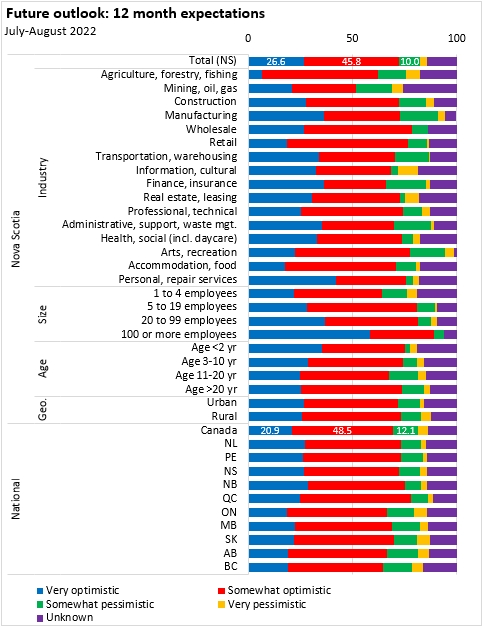
Business expectations for the next three months
The outlook for employment was stable for 77.0% of Nova Scotia businesses in the next three months. Rising employment is expected among 14.6% of Nova Scotia businesses (down considerably from April-May) while declining employment is expected by 8.4% of Nova Scotia businesses (up from April-May).
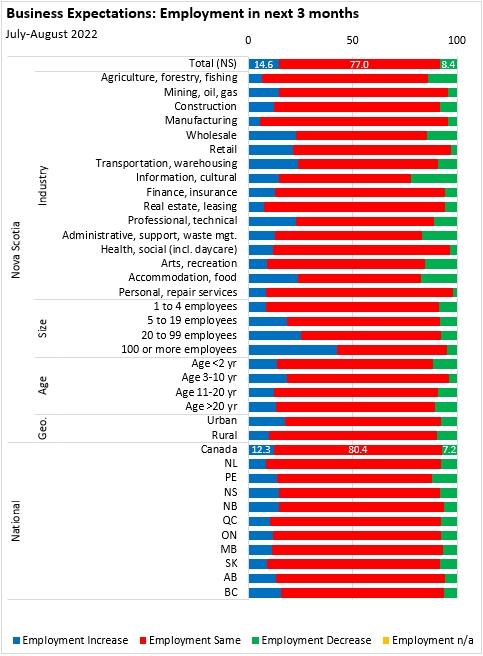
51.7% of Nova Scotia businesses expect stable job vacancies (53.2% nationally) while 9.3% expect rising job vacancies and 5.3% expect falling vacancies. Expectations of rising vacancies were more prevalent in Nova Scotia's accommodation/food, transportation/warehousing and administrative support/waste management (including call centres) industries. Across Canada, 8.2% of businesses expect rising job vacancies and 5.0% expect falling vacancies.
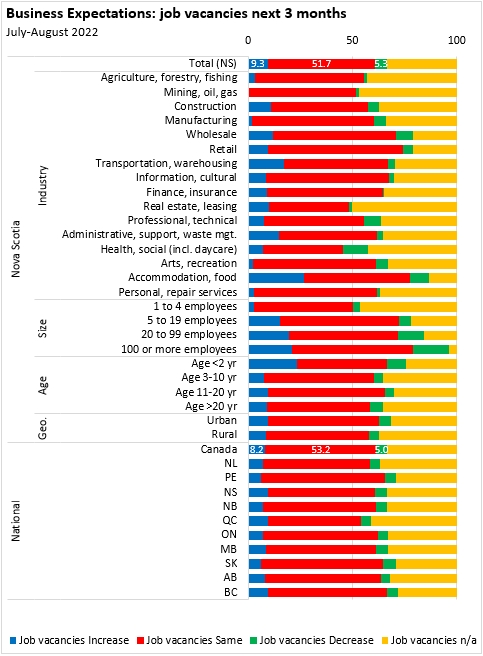
82.3% of Nova Scotia businesses expect stable or rising sales while 12.7% expect a decline. These expectations were weaker than those reported in April-May.
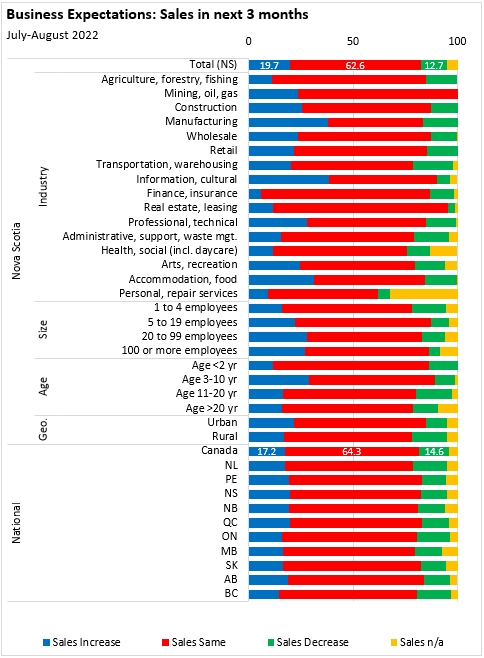
Rising prices were expected by 30.2% of Nova Scotia businesses while 58.4% expected stable prices. Only 5.9% expected price declines.
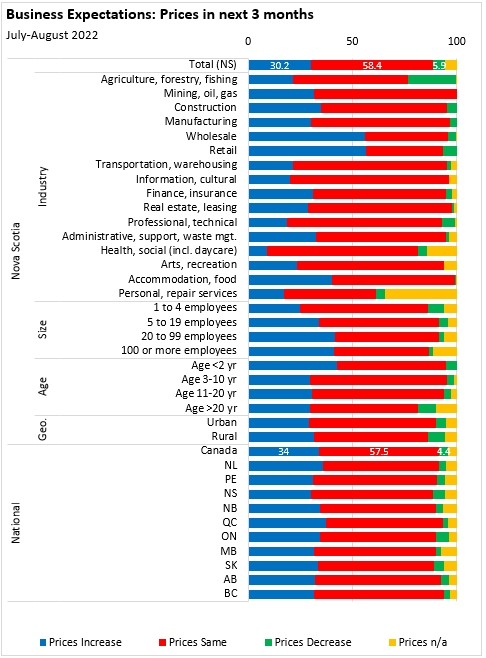
Just over 60% of Nova Scotia businesses expected stable demand while 27.1% expected a rise in demand and 12.0% expected a fall in demand. Rising demand is more widely expected among Nova Scotia's construction, accommodation/food, manufacturing, retail, information/culture and real estate/leasing businesses. Compared with April-May, a smaller portion of Nova Scotia businesses expect rising demand while a larger share expect demand to decline.
Across Canada, rising demand is expected by 22.4% of businesses while falling demand is expected by 12.9%.
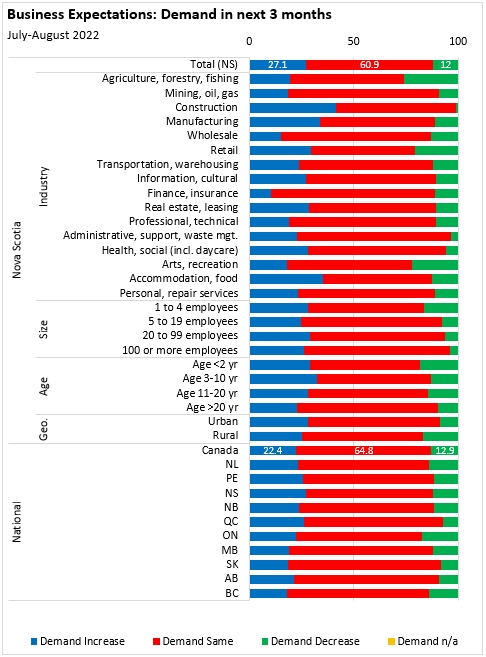
Business profitability is expected to remain the same for 51.5% of Nova Scotia businesses in the next three months while 13.0% expect rising profitability and 31.4% expect decreasing profitability. Rising profitability is expected more in Nova Scotia's professional/technical services and information/culture businesses. Decreasing profitability expectations were more prevalent in Nova Scotia's accommodation/food, agriculture/forestry/fishing, transportation/warehousing and arts/recreation businesses.
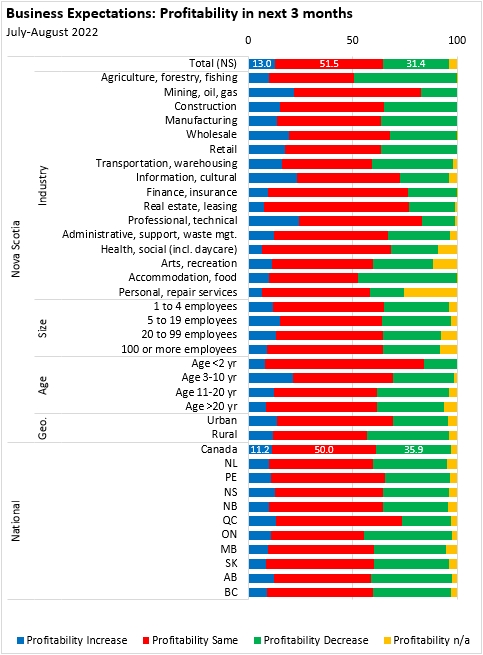
Obstacles for businesses
As part of the Survey of Business Conditions, businesses were asked about their obstacles. 19.9% of Nova Scotia businesses reported no substantial obstacles expected in the next three months. Businesses in Nova Scotia's health/social, personal/repair, real estate/leasing and professional/technical services industries were more likely to report no substantial obstacles. Across Canada, 13.2% of businesses reported no obstacles.
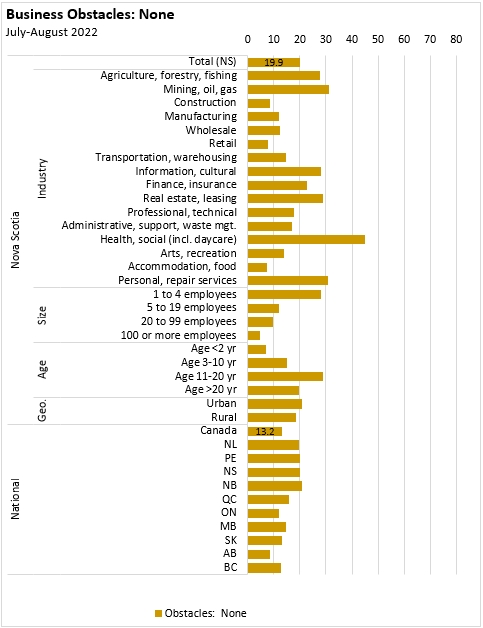
Cost factors were among the most commonly cited obstacles by Nova Scotia businesses, including rising inflation (53.4%) rising input costs (39.0%), insurance costs (31.7%), transportation costs (35.8%), interest/debt service costs (36.3%). Higher real estate property tax costs were noted as a concern by a smaller portion (16.4%).
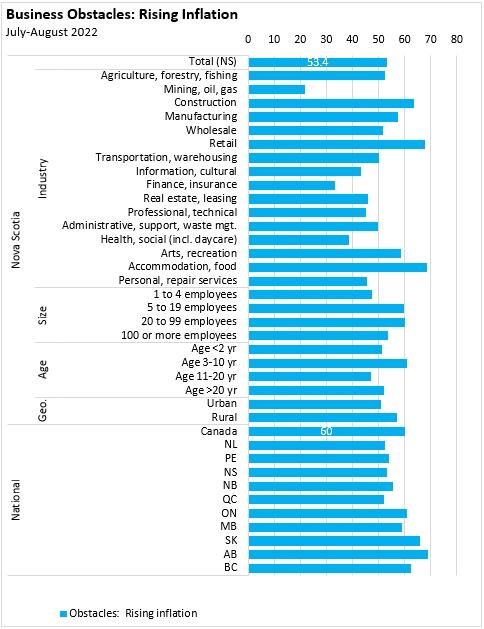
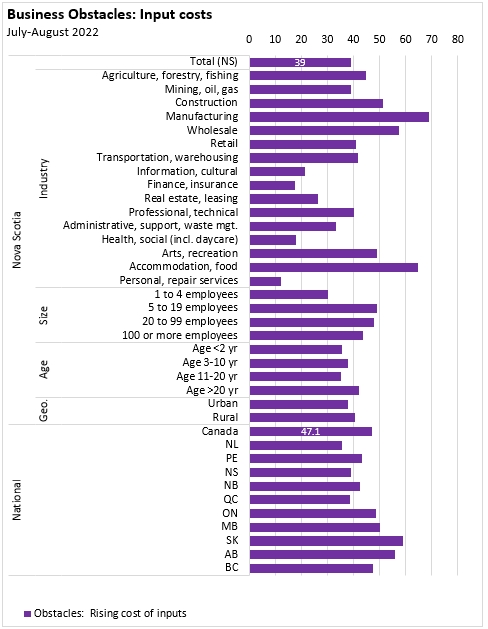
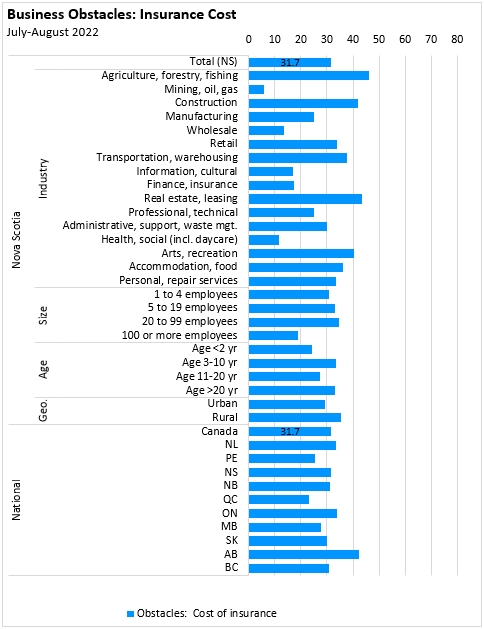
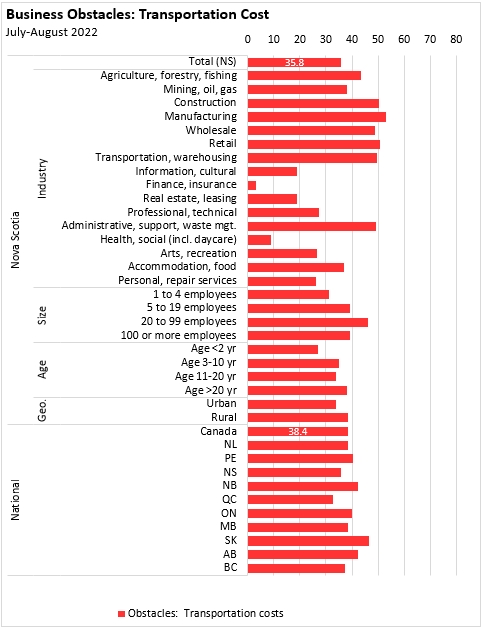
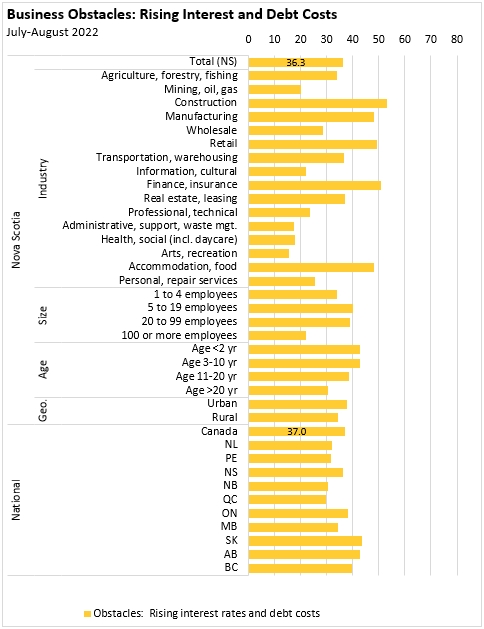
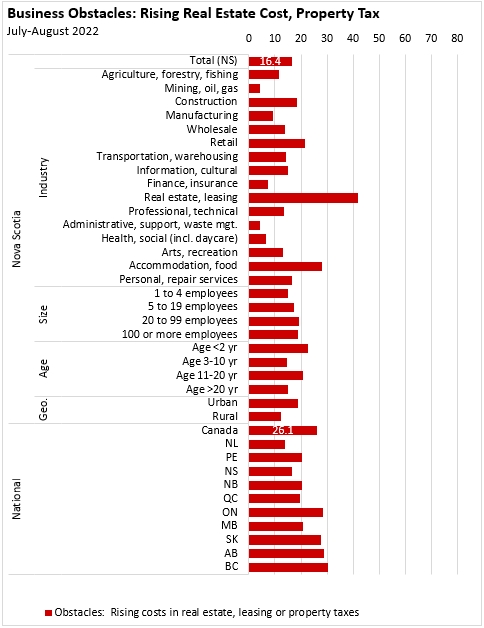
Labour shortages were noted as obstacles for 34.2% of Nova Scotia businesses. Recruiting skilled employees (34.8%) was a more commonly-noted obstacle than retaining skilled employees (25.6%).
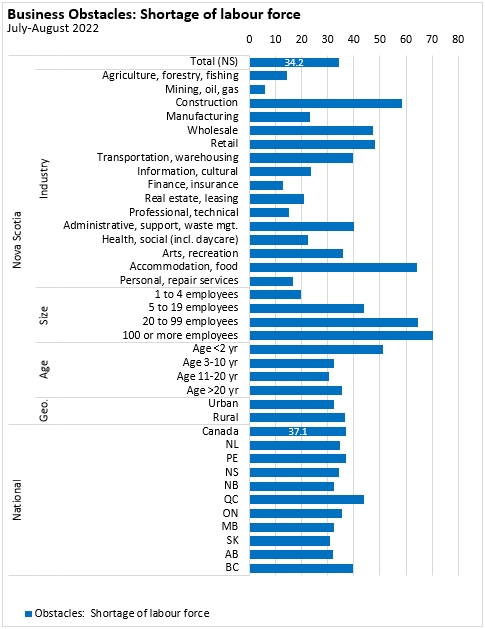
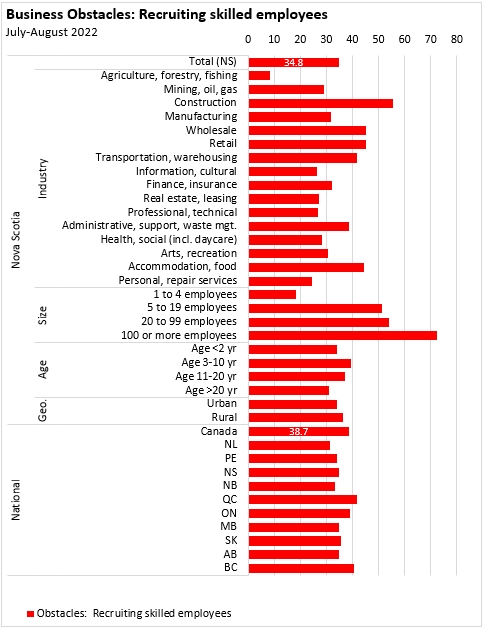
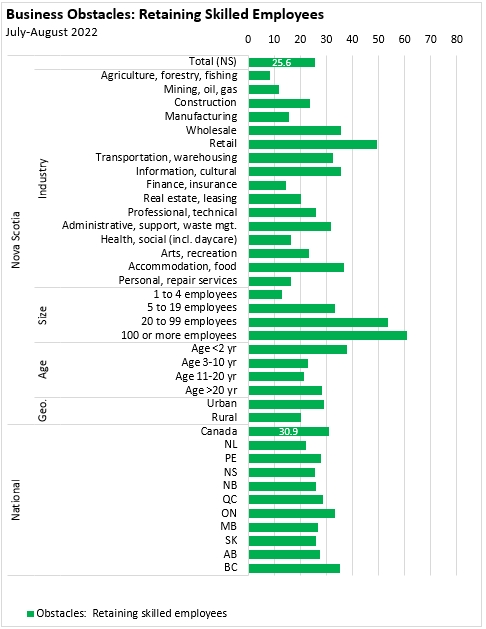
Domestic input sourcing was noted as a challenge for 24.0% of Nova Scotia businesses while international input sourcing was an obstacle for 8.7%. Both are improvements over the portion of Nova Scotia businesses noting sourcing obstacles in April-May. Maintaining inventory levels was an obstacle for 19.2% of Nova Scotia businesses (notably retail).

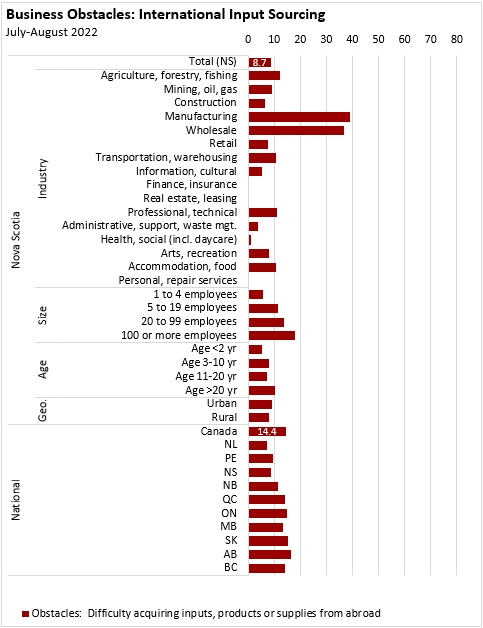
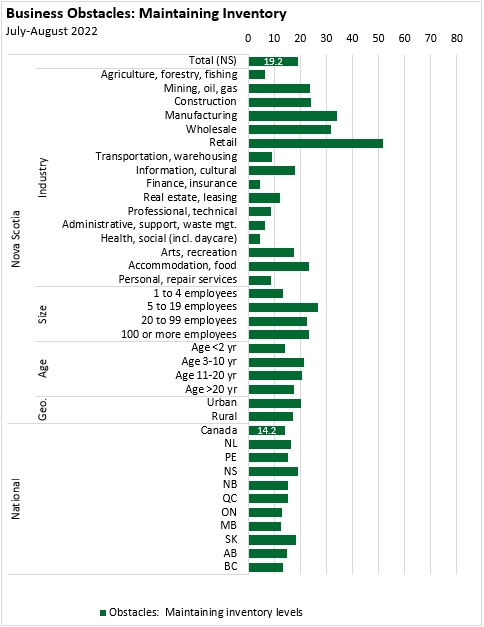
Insufficient demand (9.2%) and increasing competition (9.4%) were less commonly cited as obstacles for Nova Scotia businesses than fluctuating demand (14.8%).
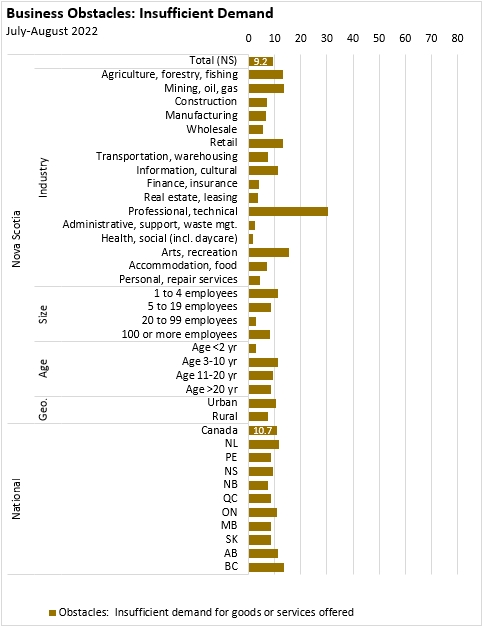
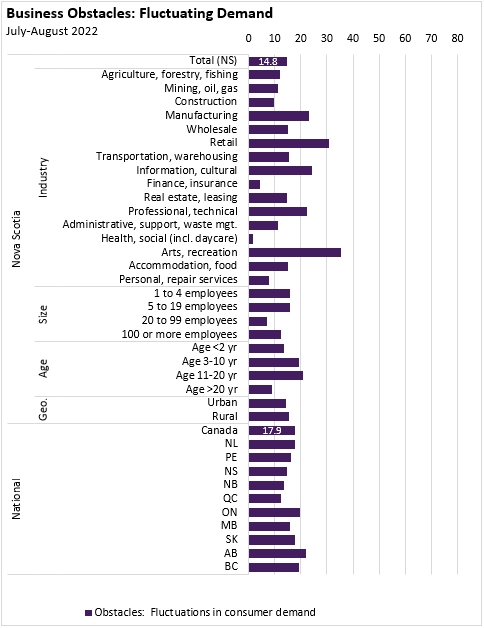
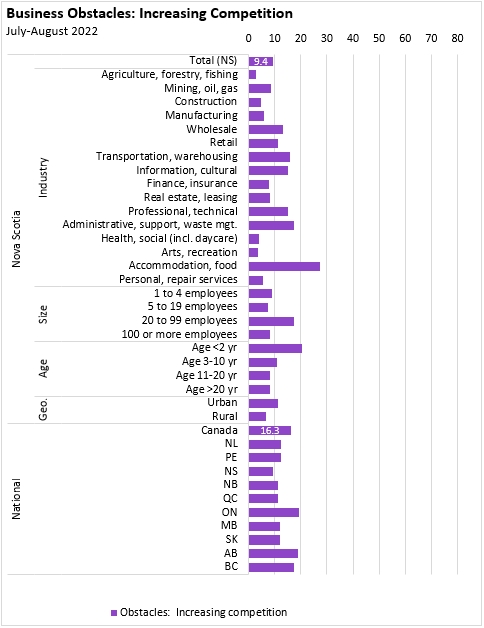
Managing cash flow and debt management (16.4%) were more substantial obstacles for Nova Scotia businesses compared with financing (8.5%).

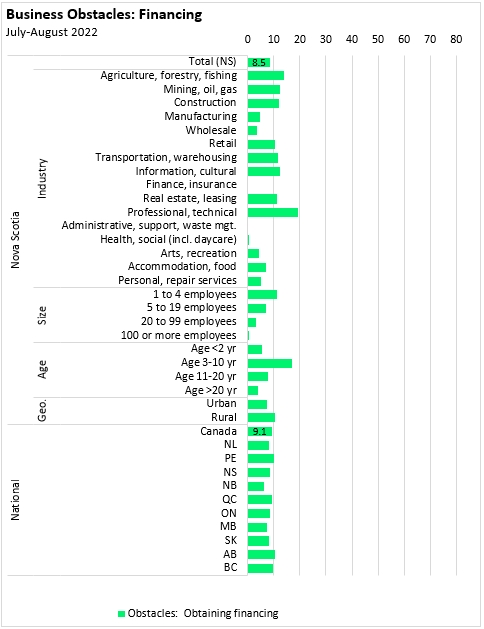
Business practices
Businesses were asked about changes to business practices considered in the coming 12 months, including supporting diversity (reported by 34.5% of Nova Scotia businesses), promoting safety (54.1%), improving work-life balance (38.7%) and focusing on mental health/wellness (37.7%). For each business practice, a higher percentage of larger businesses in Nova Scotia reported supporting these changes. Information/culture industries stood out for the share that sought to improve diversity, work-life balance and mental health/wellness.
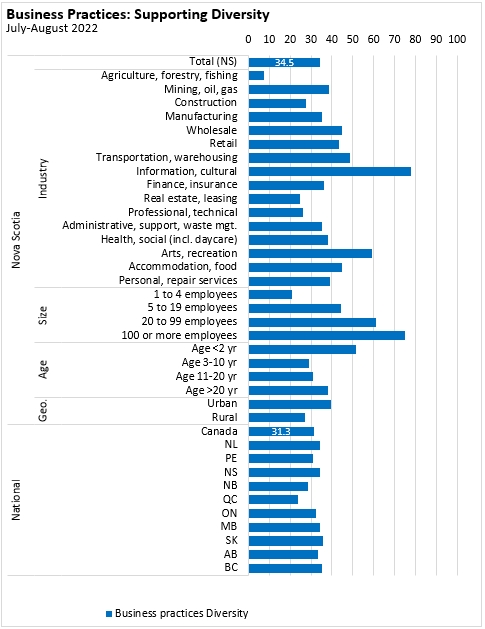
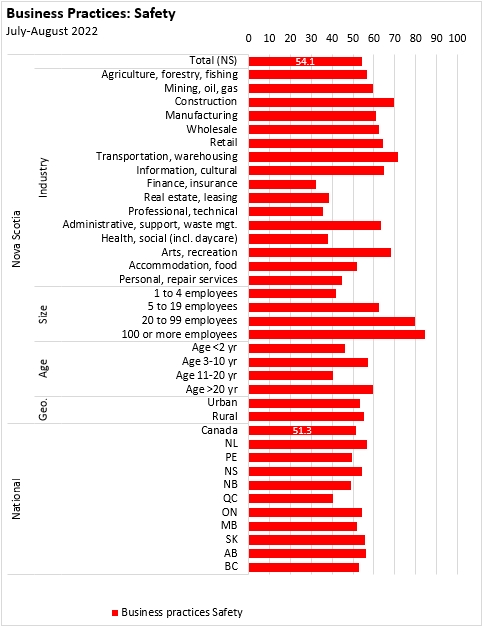
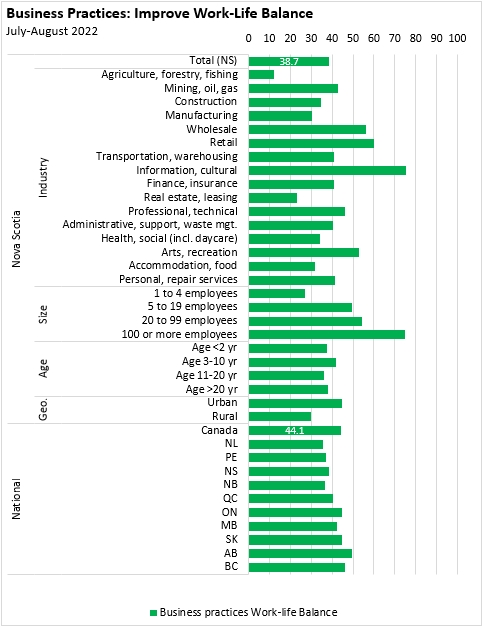
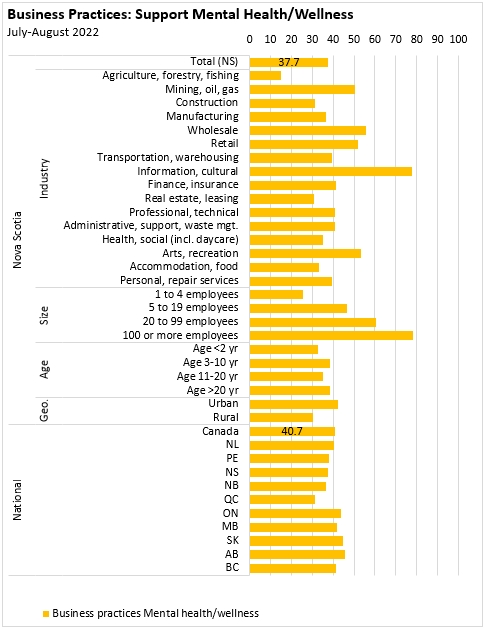
In Nova Scotia, 37.0% of businesses had unknown or no plans to improve diversity, safety, work-life balance or mental health/wellness.
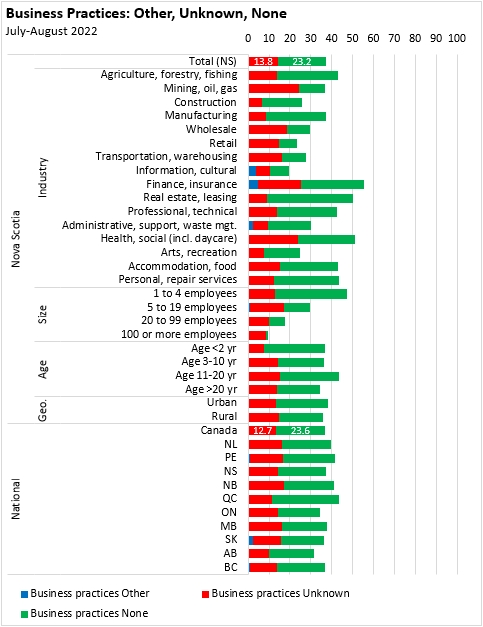
Interprovincial and International Trade
In Nova Scotia, 9.0% of businesses reported international exports while 14.7% reported international imports. Both percentages were notably higher for manufacturing and wholesale businesses in Nova Scotia as well as for larger businesses.
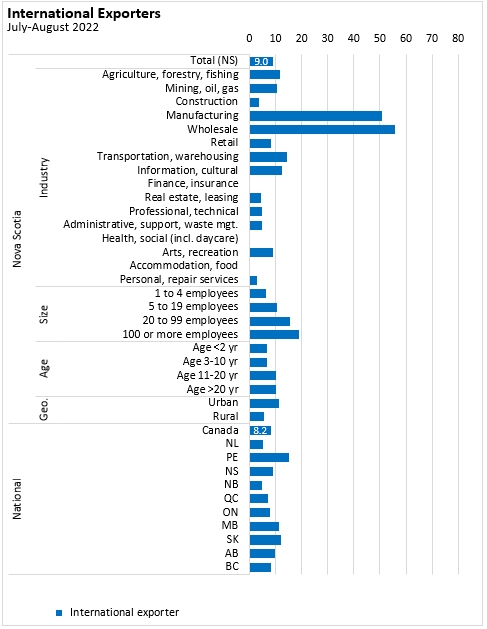
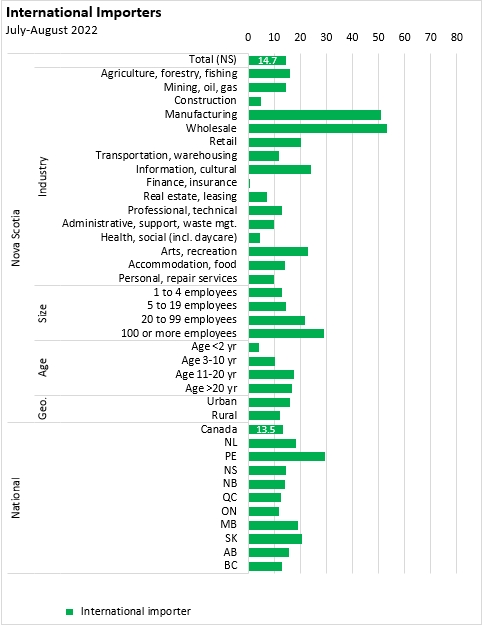
The portion of Nova Scotia businesses that exported to other provinces was lower (7.7%) than the share the exported internationally. The portion of interprovincial importers in Nova Scotia was even lower (4.8%).

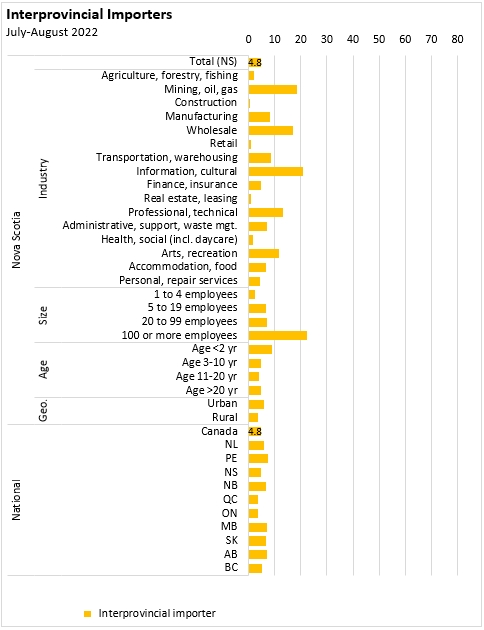
In Nova Scotia, 58.4% of businesses did not conduct export or import activities because of a lack of interest. Only 2.9% reported not conducting exports or imports because of barriers.

Among businesses with interprovincial activities in Nova Scotia, labour shortages (11.5% of respondent businesses) were the biggest obstacle to interprovincial trade, followed by geography/distance (9.9%), licensing/permitting/regulations of goods or services (9.5%), technical inspections/standards (8.1%), licensing/permitting/regulations of labour (6.2%) and taxes on goods or services (6.1%).
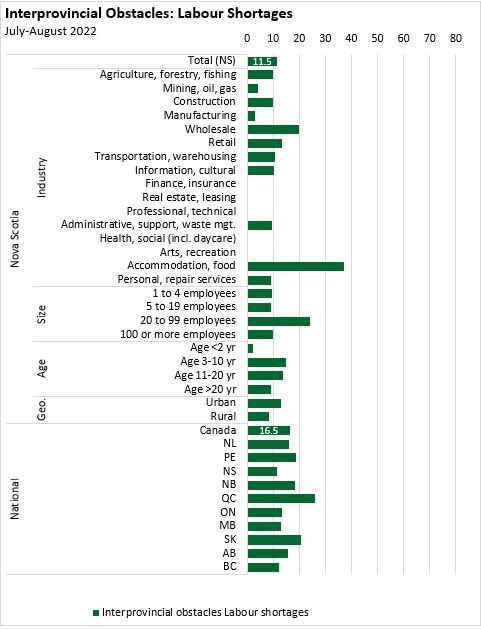

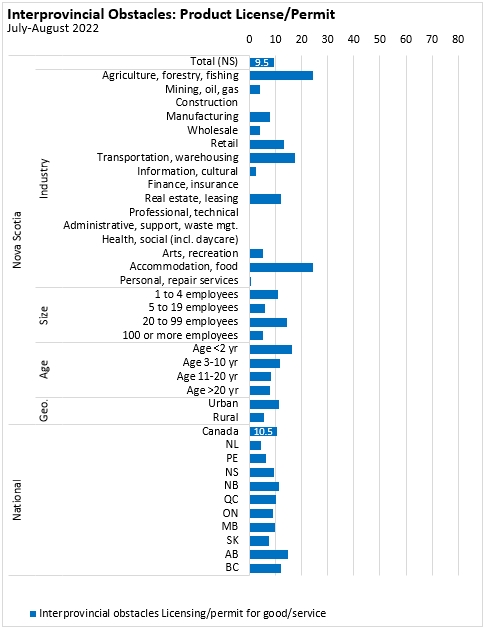
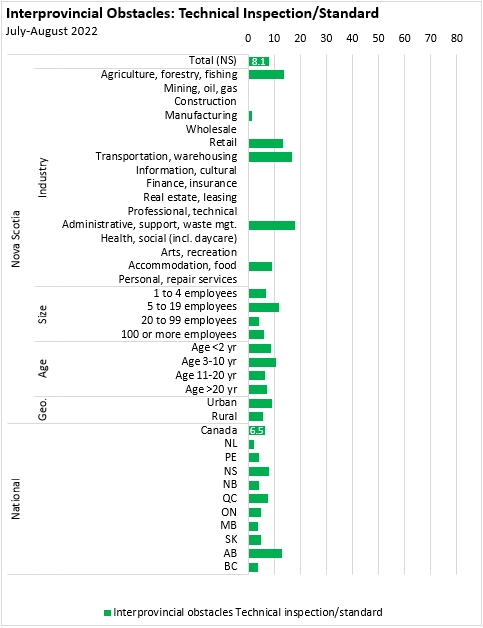
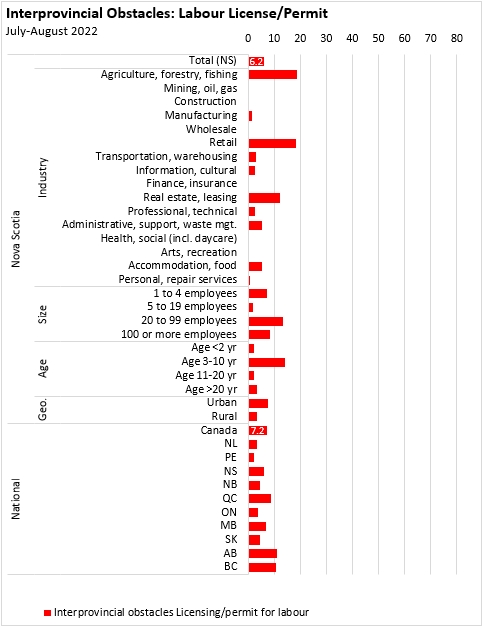
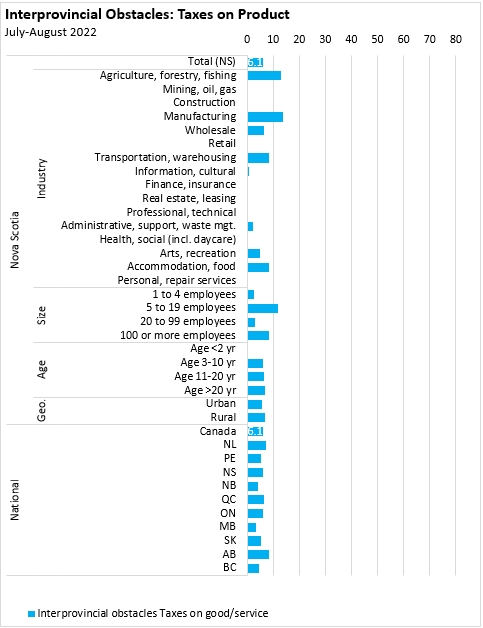
Almost half (49.7%) of Nova Scotia businesses reported no perceived obstacles to interprovincial trade.
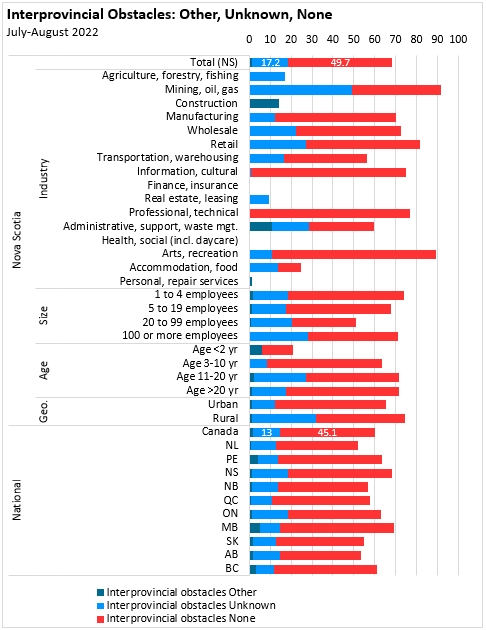
Source: Statistics Canada. Table 33-10-0567-01 Future outlook over the next 12 months, third quarter of 2022; Table 33-10-0533-01 Business or organization expectations over the next three months, third quarter of 2022; Table 33-10-0534-01 Business or organization obstacles over the next three months, third quarter of 2022; Table 33-10-0552-01 Practices businesses or organizations have in place or plans to implement over the next 12 months, third quarter of 2022; Table 33-10-0544-01 Interprovincial activities conducted over the last 12 months, third quarter of 2022; Table 33-10-0546-01 Obstacles experienced when purchasing or selling goods or services interprovincially over the last 12 months, third quarter of 2022
<--- Return to Archive